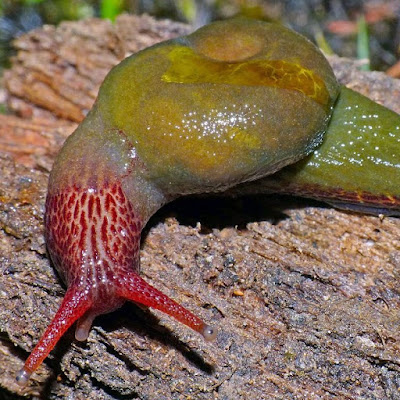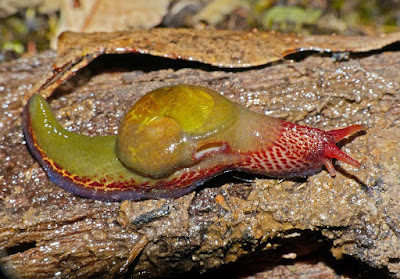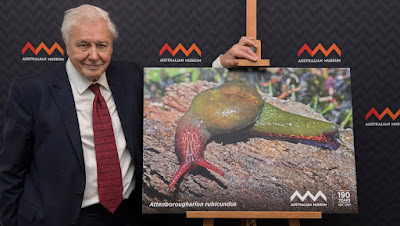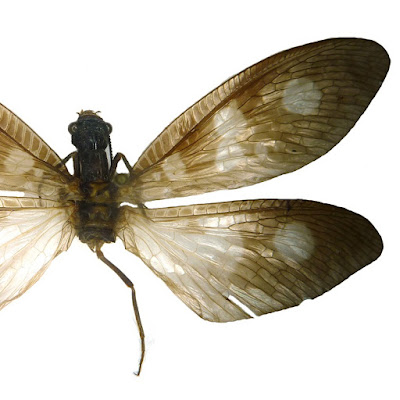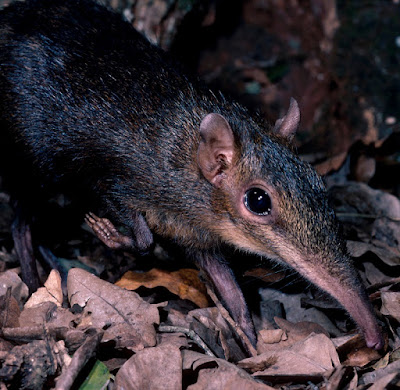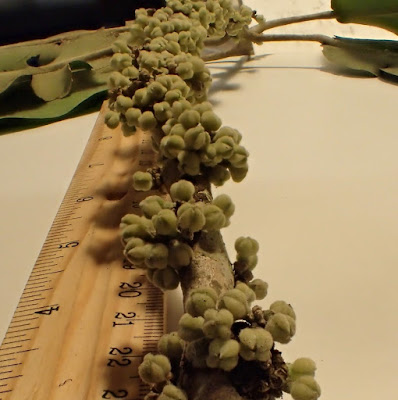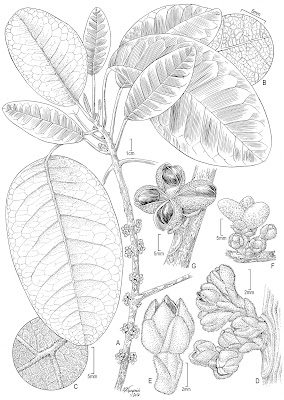[Most Recent Entries] [Calendar View]
Thursday, August 17th, 2017
| Time | Event | ||||||
| 1:40a | [Gastropoda • 2017] Attenborougharion gen. nov. (Mollusca: Pulmonata: Helicarionidae): A Likely Case of Convergent Evolution in southeastern Tasmania
Abstract Helicarion Férussac, 1821 from southeastern Australia currently comprises five species of endemic semislugs. Analyses of comparative morphological data and partial sequences of the mitochondrial genes cytochrome c oxidase subunit I (COI) and 16S rRNA (16S) reveal that one of these species, Helicarion rubicundus Dartnall & Kershaw, 1978, which is restricted to southeastern Tasmania, is not closely related to the other known species of this genus. This species is distinguished from Helicarion in several key morphological characters, such as the bright two-toned red and green colouration of its larger body with a flattened tail that is keeled only at the tip, the triangular shape of the pneumostome, the degree and type of folding present in the spermoviduct and free oviduct, the presence of a longer, more slender bursa copulatrix, the presence of a small epiphallic caecum and a hooked flagellum, and the presence of irregular longitudinal pilasters in the penial interior in contrast to the v-shaped rows of papillose lamellae seen in Helicarion. Moreover, the mitochondrial phylogeny provides evidence that this species is phylogenetically distinct from Helicarion as well as any other currently described genus from southeastern Australia. Based on these findings, we here describe a new genus, Attenborougharion, for this species. Keywords: Helicarionoidea; morphology; mitochondrial DNA; land snail; taxonomy.
Systematics Attenborougharion gen. nov. Type species. Helicarion rubicundus Dartnall & Kershaw, 1978. Etymology. Named for Sir David Attenborough, Lifetime Patron of the Australian Museum, in recognition of his lifetime’s contribution to the fields of natural science and conservation. The Latin noun arion refers to a “kind of snail or slug”; masculine.
Diagnosis External appearance. Large, shell ear-shaped, flattened, thin, golden, glossy, whorls rounded, base membraneous. Protoconch with radial wrinkles near suture; otherwise sculptured with very faint beading and indistinct to absent spiral grooves; teleoconch with very fine, indistinct spiral grooves and more prominent radial growth lines. Body colour green and burgundy. Mantle lobes and shell lappets of moderate size, none fused; shell lappets elongate, lacking pigmented warts; slime network prominent; caudal horn well-developed. Keel confined to very tip of tail; most of tail dorsally Attenborougharion rubicundus (Dartnall & Kershaw, 1978) comb. nov. Helicarion rubicundus Dartnall & Kershaw, 1978: 2; Kershaw, 1980: 213. Distribution and conservation status: Attenborougharion rubicundus is found only on the Tasman and Forestier Peninsulas in Tasmania (Taylor, 1991; Otley et al., 1999). The total known extent of occurrence of this species is 85 sq.km., leading to its listing as Vulnerable on the IUCN Red List of Threatened Species. In addition to its restricted range, within this area Attenborougharion rubicundus inhabits only closed wet forests and is not found in dry forests or damp sclerophyll forests (Otley et al., 1999), making it vulnerable to habitat loss through the effects of climate change as well as habitat destruction through changed land use. Isabel T. Hyman and Frank Köhler. 2017. Attenborougharion gen. nov. (Mollusca: Pulmonata: Helicarionidae): A Likely Case of Convergent Evolution in southeastern Tasmania. Records of the Australian Museum. 69(2): 65–72. DOI: 10.3853/j.2201-4349.69.2017.1676   NATIVE TASMANIAN SNAIL NAMED AFTER SIR DAVID ATTENBOROUGH New Aussie Snail Named After David Attenborough nationalgeographic.com.au/australia/new-a | ||||||
| 2:19a | [Entomology • 2017] Protohermes burmanus • New Species and Records of Corydalidae (Insecta: Megaloptera) from Myanmar
Abstract Seven species of the family Corydalidae (Insecta: Megaloptera) are newly recorded from Myanmar, including a new species of the dobsonfly genus Protohermes van der Weele, 1907, Protohermes burmanus sp. nov. A total of 18 species of Megaloptera are now known from Myanmar. Keywords: Megaloptera, Corydalinae, Chauliodinae, Protohermes, taxonomy, Burma Xingyue Liu and Libor Dvorak. 2017. New Species and Records of Corydalidae (Insecta: Megaloptera) from Myanmar. Zootaxa. 4306(3); 428–436. DOI: 10.11646/zootaxa.4306.3.9 | ||||||
| 4:16a | [Mammalogy • 2017] Reconstructing the Molecular Phylogeny of Giant Sengis (Macroscelidea; Macroscelididae; Rhynchocyon)
Giant sengis (Macroscelidea; Macroscelididae; Rhynchocyon), also known as giant elephant-shrews, are small-bodied mammals that range from central through eastern Africa. Previous research on giant sengi systematics has relied primarily on pelage color and geographic distribution. Because some species have complex phenotypic variation and large geographic ranges, we used molecular markers to evaluate the phylogeny and taxonomy of the genus, which currently includes four species: R. chrysopygus, R. cirnei (six subspecies), R. petersi (two subspecies), and R. udzungwensis. We extracted DNA from fresh and historical museum samples from all taxa except one R. cirnei subspecies, and we generated and analyzed approximately 4700 aligned nucleotides (2685 bases of mitochondrial DNA and 2019 bases of nuclear DNA) to reconstruct a molecular phylogeny. We genetically evaluate Rhynchocyon spp. sequences previously published on GenBank, propose that the captive R. petersi population in North American zoos is likely R. p. adersi, and suggest that hybridization among taxa is not widespread in Rhynchocyon. The DNA sample we have from the distinctive but undescribed giant sengi from the Boni forest of northern coastal Kenya is unexpectedly nearly identical to R. chrysopygus, which will require further study. Our analyses support the current morphology-based taxonomy, with each recognized species forming a monophyletic clade, but we propose elevating Rhynchocyon cirnei stuhlmanni to a full species [Rhynchocyon stuhlmanni]. Keywords: Rhynchocyon, Giant sengis, Elephant-shrews, Africa, Macroscelididae, Phylogenetics, Taxonomy Elizabeth J. Carlen, Galen B. Rathbun, Link E. Olson, Christopher A. Sabuni, William T. Stanley and John P. Dumbacher. 2017. Reconstructing the Molecular Phylogeny of Giant Sengis (Macroscelidea; Macroscelididae; Rhynchocyon). Molecular Phylogenetics and Evolution. 113; 150–160. DOI: 10.1016/j.ympev.2017.05.012 Collections at the California Academy of Sciences [@calacademy] aid researchers in revising a mammal branch on tree of life http://phy.so/420885974 via @physorg_com | ||||||
| 4:31p | [Botany • 2017] Melicope stonei section Pelea (Rutaceae) • A New Species from Kaua‘i, Hawaiian Islands: with Notes on Its Distribution, Ecology, Conservation Status, and Phylogenetic Placement
Abstract Melicope stonei K.R. Wood, Appelhans & W.L. Wagner (section Pelea, Rutaceae), a new endemic tree species from Kaua‘i, Hawaiian Islands, is described and illustrated with notes on its distribution, ecology, conservation status, and phylogenetic placement. The new species differs from its Hawaiian congeners by its unique combination of distinct carpels and ramiflorous inflorescences arising on stems below the leaves; plants monoecious; leaf blades (5–)8–30 × (4–)6–11 cm, with abaxial surface densely tomentose, especially along midribs; and very long petioles of up to 9 cm. Since its discovery in 1988, 94 individuals have been documented and are confined to a 1.5 km2 region of unique high canopy mesic forest. Melicope stonei represents a new Critically Endangered (CR) single island endemic species on Kaua‘i. Keywords: Rutaceae, Melicope, M. section Pelea, new species, conservation, Hawaiian Islands, Kaua‘i, Critically Endangered
Melicope stonei K.R.Wood, Appelhans & W.L.Wagner, sp. nov. Diagnosis: Differs from Hawaiian congeners by its combination of distinct carpels and ramiflorous inflorescence; plants monoecious; leaf blades (5–)8–30 × (4–)6–11 cm, with abaxial surface tomentose, especially along midribs; and very long petioles of up to 9 cm. Etymology: We are pleased to name Melicope stonei in honor of Benjamin Clemens Masterman Stone, British-American botanist, born in Shanghai, China in 1933 and passed in 1994 while working at the Philippine National Museum on the Flora of the Philippines Project. He contributed over 300 publications to science during his career, including taxonomic monographs of Hawaiian Pelea (Stone 1969) and Platydesma (Stone 1962). For all his contributions, especially his keen insights into Hawaiian Melicope, we gratefully extend him due recognition. .... Kenneth R. Wood, Marc S. Appelhans and Warren L. Wagner. 2017. Melicope stonei, section Pelea (Rutaceae), A New Species from Kaua‘i, Hawaiian Islands: with Notes on Its Distribution, Ecology, Conservation Status, and Phylogenetic Placement. PhytoKeys. 83: 119-132. DOI: 10.3897/phytokeys.83.13442 A new critically endangered tree species depends on unique habitat found only on Kaua'i phy.so/422107940 @physorg_com A new critically endangered tree species depends on unique habitat found only on Kaua'i blog.pensoft.net/2017/08/16/a-new-critic |
| << Previous Day |
2017/08/17 [Calendar] |
Next Day >> |
